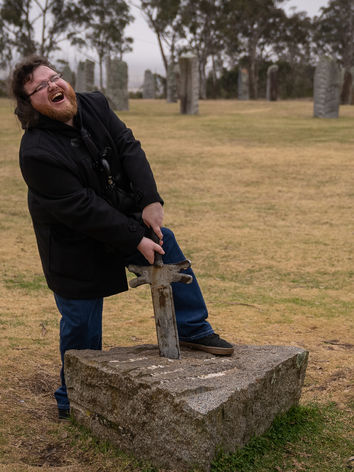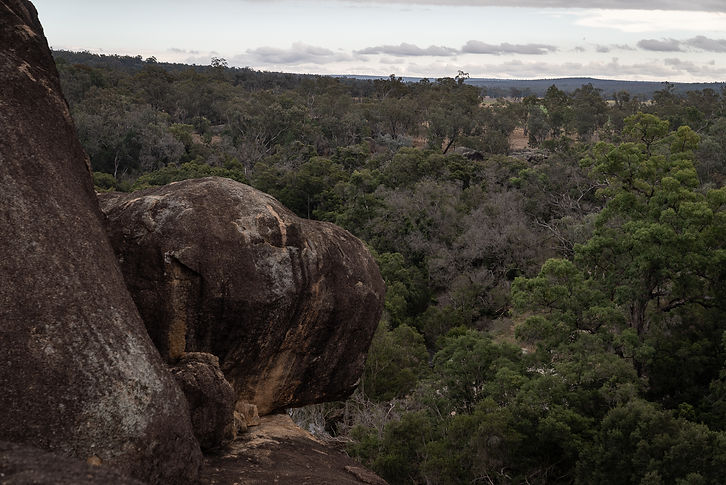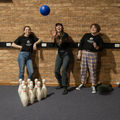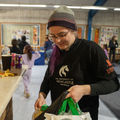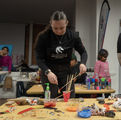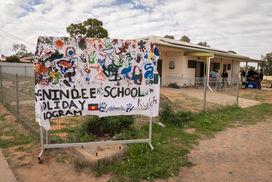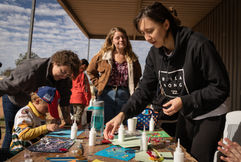 |
|---|
Ma & Morley 2022 Cultural Immersion Trip
Welcome
to Our blog
In 2022, the 2020 Ma & Morley Scholars took an 11-Day Cultural Immersion through western NSW. We have captured the shared experiences of the 13 Scholars on the journey through a day-to-day reflective blog.
Day 1: Monday 4 julY
We gathered at the Wollotuka Institute on Awabakal Country. Nerves, excitement, and anticipation for the journey ahead. Old faces reunited again. We gathered our luggage in laughter where some questioned whether they had too much stuff or too little. We then made our way to where smoking ceremonies are held at the centre. Due to the weather, a smoking ceremony was not possible therefore we were introduced to another ceremonial practice, The Brush Down.
The leaves of a eucalypt brushing from our head down to our feet. Brushing away the negative to invite the good, to let ancestors of the Pambalong clan on Awabakal Country to take rest as we leave to journey off to different country as we will become into the hands of the Gamilaraay people...
Newcastle
Wollotuka Institute
They will guide and protect us as we journey across country to be immersed in the land, waters and story of the Gamilaraay people

tamworth
NEWCASTLE




TAmworth
Gomeroi Dance company
What really stood out about Gomeroi Dance Company was how they have engaged the young people in their community, and how they are so connected to each other and their culture. Each of the dances that we witnessed and participated in with the Gomeroi dancers had unique movements for each of the stories they represented. I haven’t seen anything like it before, it was a really raw and visceral experience.
We were lucky enough to have a chance encounter with Uncle Neville Sampson, a local Elder and proud Gomeroi man who welcomed us to Country, which made the day even more special. The talk that Marc Sutherland, the Co-Founder of Gomeroi Dance Company and the Director of Gomeroi Culture Academy, gave was really inspiring, and he treated everyone as an equal participant on the day.
At the smoking ceremony, I was feeling a little hesitant, but I ended up really enjoying it. The smoking ceremony felt like a different kind of smoke. It was really cleansing, I didn’t know if it would be, but it was.
I thought our time in Tamworth was so profound. The resilience of the community really stood out, which is a real testament to their people and their culture. The colonizers did their most to wipe out this culture, but here they are, strong and powerful.
I am not religious, but I appreciate the rituals that go with spirituality and religion. These rituals reminded me of that feeling I’ve had in other spiritual or religious contexts.
I was thinking I hope other young people in Newcastle get to experience this too.
Glen Innes
Tamworth
Day 2: Tuesday 5 july
Glen Innes
Celtic Stonehenge
It was great to see the Celtic Stonehenge overlooking Glen Innes a small mountain town in rural NSW. Created in 1992 from a series of large granite columns, the impressive site reminded me of the Celtic connection here that traces back to early settlers and convicts. The site reminded me of Celtic culture and its personal importance through my own history and Scottish heritage. Listening to Uncle Paul talk, for the first time I realised the resemblance and importance of clans among Celts and mob and tribes here among Indigenous Australia.
My major understanding of Celtic clans had a lot to do with their man-made structures that were embedded with meaning and stories, some examples include Stonehenge and a number of castles that dot the British Isles today. On the other hand, Indigenous communities across Australia have deeply connected stories to nature and the landscape.
There are two major distinctions between these Indigenous cultures for me, one being the periods of time they’ve thrived, here Indigenous Australian culture has been living with the land for more than 60,000 years while the Celts on the other hand are believed to date back a few thousand years. The other takeaway for me is around the relationship with the land, I had assumed the Celts had predominantly connected to the land through structures but that might not necessarily be the case. Learning stories and connecting to Indigenous culture here prompts me to consider the connection and importance of land by all indigenous cultures around the world, even the Celts who are my ancient ancestors.
Warialda
Glen Innes

Warialda
Cranky rock
Whilst out at Cranky Rock, Uncle Paul guided us through Warialda Country and told stories about the history of the beautiful granite Country. He told stories about the origins of the boulders and the preservations of the poison and python ancestors from the Dreaming. I reflected on how these stories linked with science as a geology student. The knowledge of the past being so accurate before science was very powerful and showed a strong connection that elders past present and emerging have with the land and how these stories get passed down.
Uncle Paul shared a story about the angry emu causing an eruption that ejected the basalt magma forming the standing granite boulders and about the importance of water holding all ancestors have been passed on since time and were told to us today.


Not only was it incredible to hear these stories firsthand but I was mesmerised by how accurate Uncle Paul’s recollection was from the formation of the landscape from early time to how it looks today.
I am from Newcastle but the sense of calm I felt there was something so special. It just felt different that connection with the Country. Looking down over the gorge you felt how sacred the space was and, at that moment, it made sense when Uncle Paul Gordon talked about how this was once a sacred space, and how people didn’t swim in the water.
It’s not just about preserving a rock it’s about continuing the sacredness of the culture that helps to tell the stories of a place and people.
How are we meant to continue culture if Indigenous Australians are not allowed to connect with sacred sites?
Moree
warialda
Day 3: Wednesday 6 July
moree
Miyay Birray Youth Services
NAIDOC Activities
Today was my first time attending a NAIDOC event so I didn’t have too many expectations of what the day would hold. With the drizzly weather in the morning, I thought it might mean there wouldn’t be too many people in attendance but soon enough the community space was full of families who had come from across Moree to participate in the NAIDOC celebrations organised by local Indigenous youth service Miyay Birray.
Throughout the day myself and other scholars were helping out on a range of stalls. Some of us were assisting with the sports and games while others were helping with face painting, hair spray, and arts and crafts. Kids ranging in age from 2 through to 12 participated in activities. At our stall, the kids would come to do painting or have their hair sprayed.
It was then during those activities that I had the opportunity to chat with the kids.

Plenty of the younger kids were eager to chat and tell me about their school and hobbies while some of the older kids destined for boarding school in a few years asked us about the differences in the mode of study between high school and university. Many of the kids who chose to paint would choose to use the colours black, red and yellow. Whether painting the flag or just using the colours in combination it showed to me that these kids were really connected to their culture and had learnt from their elders. Some of the kids turned over their brushes to use the ends of the brush to create dot paintings. Some kids told me they’d never had the chance to do dot paintings before but they had observed them being done by family members or elders in the community. For me, this was another example of observing the kids eager to connect with and live out their culture and I found this really incredible.
Sharing NAIDOC week with the community in Moree really inspired me to want to connect more in my own community. Whether this is volunteering, going to NAIDOC events or connecting to Indigenous organisations at home, I am eager to take my newfound knowledge into my community and encourage others to learn about how we can not only preserve but also continue the world’s oldest living history.
In the evening, Lloyd and Darrel from the Miyay Birray Youth Service cooked up a kangaroo curry for dinner, and we had really interesting conversations about unequal wealth distributions and the disadvantages students from Aboriginal backgrounds can face in small towns like Moree. It was apparent from the conversation that there is a lack of equal employment opportunities for Aboriginal and Torres Strait Islander people, particularly when trying to fit in with Western society's standards, which typically require formal qualifications. Darrel called for all teachers and university graduates to get involved and connect with communities, and not be shy, as this is part of the solution to inspire the youth and give them the support to get these opportunities. They were impressed with the University of Newcastle for taking the steps to connect.

moree
Miyay Birray Youth Services
Dinner
Day 4: thursday 7 July
walgett
moree


walgett
Picnic & newsagency












walgett
Story by the river
Hearing Uncle Paul speak about all the different trees and their benefits and medical uses was absolutely mesmerising. We walked through bushland just off the side of the road and ended up by the riverside where a smoking ceremony was being set up for us by Dave. It’s incredible to think we’re surrounded by the world’s oldest living culture and to hear about its intricate nature was such a unique experience. Something that really stuck out to me was the six L’s that Uncle Paul taught us about leadership; lore, love, listen, look, learn and lead. This methodology isn’t practised in the traditional Western world and looking at leadership as not just an individual practice but something that involves a whole group of people was eye-opening.
This isn’t a way I’ve looked at leadership before, so this conversation allowed me to reflect on my own leadership style and the importance of sharing my knowledge with others in the community. I was also able to acknowledge that leadership is a never-ending journey and there is always more to learn. Uncle Paul also used a helpful metaphor when describing how to build relationships with Indigenous organisations in our communities in that he compared it to building a romantic relationship. This will assist me greatly in building more of a connection in my local area and I am eager to apply all the knowledge Uncle Paul has instilled in me in my own life.

day 5: Friday 8 July
walgett
Aboriginal Medical Service
Hearing how hard it was to balance the demand for rural health services with funding, availability and accessibility made me reflect on the dedication and importance of centres like the Walgett Aboriginal Medical Service centre. I realised these centres were doing more than just checkups. WAMS was providing specialised health care outreach from doctors, dentists, and dermatologists to prenatal and maternal care, cardiologists, psychologists and endocrinologists to name a few. They were also providing the primary health advocation for the towns and working on deliverable projects to tackle multifaceted health issues in the community.


One of the biggest challenges was being able to educate the community about health when the community can’t afford essential health services, doesn’t have access to fresh foods and has more pressing issues to deal with. With extensive social disadvantages, good nutrition is not able to be met by the majority of people. I reflected on the frustrations of the centre to be able to tackle health targets without more financial backing, improvements to living conditions and the distribution of resources.
After reflecting on the issues with health in these communities, I was inspired to integrate my field of research with socially disadvantaged communities to bring the issues to the forefront. I hope this will lead to change in the way governments measure success in these programs and highlight the need for improved resources.
Brewarrina
walgett

Brewarrina
aboriginal Cultural museum
Reflection 1:
The Brewarrina museum looked small from the outside, but surprisingly once inside it was blue in colour and dark in sections, but full of information and things to learn about. The museum was situated up the hill next to the Barwon River. The tour guides within the museum were found to be full of knowledge and made sure everyone understood what was being said before moving on to new information.
We learnt about the Indigenous culture that existed in the local area and has existed here for more than 60,000 years and the tools they used to survive including different types of boomerangs, an emu caller, shields, canoes and coolamons. Within the museum, we first learnt about the fish traps through knowledge from the tour guides, but also within the museum was a model of the fish traps within the Barwon River. We couldn’t see the fish traps as the local Barwon River was very high. It really blew my mind how much the water has risen over the fish traps, however, I still felt so grateful to be shown where they are and the history behind them.
After we finished being shown around the museum and gathered around as a group down by the bank of the Barwon River, Dave asked us all to take a seat, close our eyes and really connect and think about the water whilst he performed a special song to us all.
Overall, I felt a real strong connection to land, as a whole and a sense of calmness whilst down by the river banks. I hope to continue this feeling and sense a stronger connection when on my own land of Wiradjuri.


Reflection 2:
Bradley provided a very informative tour of the Brewarrina museum. There was an extensive range of artefacts, historical records and stories, which showed how Indigenous people lived on the Barwon River during pre-colonisation, European invasion, and dispossession, to now in the present. The fish traps were fundamental to Indigenous society, used as the primary hunting place as well as a meeting, sharing and trading place. The Barwon River was a particularly significant meeting place for several tribes who came together to build the fish traps and shared the resources. Other artefacts including tools, fossils, weapons, and a replica of the traditional shelters highlighted how Indigenous people lived, hunted, taught and held ceremonies long before colonisation.
I particularly reflected on how Bradley spoke about the misrepresentation of Indigenous culture from the racist narrative. He outlined that Indigenous people weren't only hunters and gatherers, and explained that the ingenuity of the fish traps on the Barwon River is a testament to that. I reflected on feeling guilty as I wasn’t taught about these structures built over 30,000 years ago which truly showed brilliant science, engineering, and architecture. Everyone should be taught about the innovation of Indigenous people who used intergenerational knowledge and experience to build the most efficient fish trap system well ahead of Western engineering. This example was very impactful as it is so logical and made me realise how Indigenous culture has been misrepresented in Western society in so many ways without me realising it.
The museum also had artefacts from the Brewarrina mission which showed the devastating ways Indigenous people were treated during the hospital creek massacre, and mission camps which forced Indigenous people out of their homes and dispossessed them of their culture. I reflected on all of the stories and impacts of this I have learnt on this trip from different places and what I want to do to change the narrative. All of the learnings I have taken away have made me realise I want to help educate others who were not taught about these issues and bring them to the forefront of any work I do in the future with Indigenous communities.
Brewarrina
orana haven

In Brewarrina, we had dinner at Orana Haven. We ate emu, kangaroo, and pork, all caught and prepared by the men at the retreat. It made me think about how food brings people together - there were people from all walks of life sharing that meal. Knowing the food had been recently caught made me feel a greater connection and appreciation for the food I was eating than I think I've ever experienced.
We gathered around a fire, and a few people played music. Rod played one of his original songs on guitar, and Su played the fiddle. There was a real feeling of togetherness. A particularly powerful moment for me was when Archie played the didgeridoo. To see a young Indigenous boy sharing his culture with such a diverse group of people - the scholars, his dad, the participants in the program, Uncle Paul, and Dave - felt like a real moment of connection and hope. It was fantastic to see the confidence and pride Archie had, and I hope he felt how much we all appreciated his playing.
Brewarrina
Hospital creek massacre site
On Friday night we were taken to the Hospital Creek massacre sight where 400 Aboriginal men, women and children were killed. Standing there under the stars and looking over the land had a massive impact on me. It was heartbreaking to know that on this land so many people had been murdered.
Looking out towards the horizon and seeing the lights sparkle these lights were said to be the souls of people that were killed and still need to be put to rest.
Being at the sight and being able to pay respect to the people that had passed was so important to everyone on the trip.
It was an amazing opportunity and even though it was heartbreaking I’m extremely glad we were able to go pay our respects.

Day 6: Saturday 9 July
Gundabooka
brewarrina

uncle Paul Gordon
As he walks deliberately across the country, the physical and spiritual connection is strong. He takes pride in sharing the stories and teachings of his ancestors with the new generations. Uncle Paul Gordon has had a profound effect on our journey over the 11 days. His knowledge and storytelling of the land, the people, and the culture are undeniable. He is an incredible communicator and teacher of Indigenous culture. His emphasis on connection to all aspects of culture is one of the many things that I am definitely taking away from this experience.
Uncle Paul used examples of larger corporations coming to these remote communities with either products or services they think the community needs. While some of the intentions may be good and others may be questionable, most of these companies don’t make an effort to spend time connecting with the people and the land. This is incredibly important in order to truly understand what can be done to help. I will certainly be using these teachings in my hopeful future work with marginalised communities. It has been an absolute pleasure to have met Uncle Paul and I’m certainly looking forward to learning more from reading his book and future experiences... and don’t forget those hilarious jokes hahaha.
cobar
Gundabooka



cobar
sound chapel
Orange Cobar sunset. Big sky. A monumental steel tank glows warm rust-red on this hill at the edge of town. Once filled with water, we’ve come to experience its new purpose.
We pick our way through the low scattered plants on the dark side of the tank, unsure of what to expect. A new concrete form juts out. The passage into the sound chapel. Inside a smooth terrazzo floor turns into loose clattering river-stones underfoot. The tall pointed arch at the end of the passage signals that we’ve entered a sacred place, of sorts.
Inside, a cube within a cylinder. Concrete within steel. Gently lit. Some press into the corners. Others on the floor and square seat in the middle. All tracing up to the open sky through the hole in the ceiling – a golden eye with a waxing moon sending a circle of light to the floor.
We make our own noise for a time: a curious mob exploring the inner-outside space between the chapel cube and the tank shell. Ganging about. Crunching stones. Boom-pounding the walls - testing resonance.
Eventually, everyone settles inside the cube. The racket of pebble-stomp subsides and the audio track of the chapel begins. Listening. Barely audible at first. Intriguing plucks, scrapes and other-worldly tones spiriting around. More sound-scape than melody. By turns warm, friendly, quirky and unsettling.
One brings out a guitar to sing. It’s hard to predict how a relatively ‘normal’ song could work with these peculiar waves of abstract composition.
He sings it straight. A heart-felt song about ancestors. Fine voice and guitar enhanced by the generous acoustics. Meanwhile, the chapel’s endemic soundtrack continues around us - not in key with the song, nor sharing anything in common; yet it sits comfortably as a strange spirit layer – adding depth and dimension.
Stilled by our moment of esoteric wonder, we step quietly out into the night. Our coach glows in the dark with lurid colours, like an alien ship ready to whisk us away.
Day 7: Sunday 10 July
Menindee
Cobar

menindee
Sunsets
At the furthest point of our trip, we spent two nights in the small town of Menindee, about an hour from Broken Hill. We spent both of those nights watching the sunset by the lakes. It was a serene experience where one could just switch off and relax watching this once-in-a-lifetime experience of the sunset over the full lakes. What I was told was a rare occurrence by the locals. But also there was the company. Particularly on the second night when a pair of the local teachers took us on their school bus to their spot on the lakes and we sat and told stories to one another. There was a sense of being in the moment where for a short while, this little part of the world was all there was.
In general, Menindee had a great sense of place. It was quiet and the only break in the calm was the town's great community. Even the dogs were wandering towards gatherings of people for pats. I felt safer walking down the pitch black dirt back roads than I do walking down the street I live on. Being a city person I don't think I ever really thought about living in a rural area like Menindee though my time there has me reconsidering.
Throughout the two nights we stayed in Menindee, we had the pleasure of watching the sunset by the river both nights. I felt a strong sense of community as we all shared the special moment together and felt so connected to the rest of the group and the beautiful country we live on. At that moment there was nowhere else in the world I wanted to be.
It was a reminder for me that no matter what happens during each day, the sun is always going to set and it is always going to rise the next day. It has also encouraged me to connect with the earth more and appreciate the little things.


Day 8: Monday 11 July
menindee
Central School
We spent two days at Menindee, residing at the Burke and Wills Menindee Motel. From the moment we arrived at Copi Hollow for sunset on the first night, I was captivated. I knew that there was something special and magnetic about this place, and I am sure we all felt it too. We ate pizza from Menindee cafe made by Daniel Fusi, the local legend, by the water's edge in the company of the seagulls flying, pelicans dipping and the ripples left by fish feeding. Uncle Paul and Dave lighted the campfire, and we soon settled around watching the sun go down.
We woke up to bacon and egg rolls and coffee from Conor’s cafe: The vegos of the group faired much better for brekkie this time around; they scored hash browns and even some lettuce! Daniel picked us up in the school bus from the motel and drove us around town, showing us all the sights. The rickety ride and his sense of humour gave us all a good laugh. I think we can all agree that Daniel should be appointed Lord Mayor of Menindee. We joined in the holiday program run by the school and spent a few hours with the community doing arts and crafts, playing build-up tips and crocodile-crocodile. The kids sure did give us a run for our money; we didn’t stand a chance! I think most of us left the community pretty exhausted but still feeling elated. Driving to our next stop, I couldn’t stop thinking to myself, wow, what a community. Their school, where Daniel is a senior leader and Fiona, an admirable woman, is the principal, is the central hub. They don’t separate education and community; rather they are inextricably connected, feeding and thriving off their connection. The students have access to so much support, love, care, and positive energy - it’s no wonder they have a 95% retention rate till year 12. Being a teacher myself, I think we have a lot to learn from Menindee Central School.

Back on the rickety bus, Daniel took us out to Kinchenga National Park, where we checked out the old wool sheds. I think the general consensus made was that sheep-shearing back in the day was not the most easiest of jobs. We went out to Lake Menindee to watch the sunset over the weir, another breathtaking view surrounded by life of all forms and filled with grins, laughs, and a few cups of tea. After the golden glow left us for the evening, we returned to the community centre for the most incredible dinner of curry cooked in the camp ovens. By the warmth of the campfire and chilli, we gathered, and ate, and laughed, and shared, and connected with Menindee. A few of us finished the night at the Maiden’s hotel with a very, very slow game of pool and a good laugh.
We woke to another morning in Menindee, and Daniel gave us a tour of the Central School. What an incredible teacher and an incredible school. Like I said before, I think we have a lot to learn from Menindee and their community. Community and connection are everything, and Menindee is undoubtedly doing it right.
As I write this, we are on a bus leaving Menindee, but I still feel the magnet in full force. I know I will be back to Menindee, and next time, for a much longer sunset.
Day 9: Tuesday 12 July
Cobar
Menindee
dAVE nEWHAM
To be in the presence of Dave is to be in the presence of a man who is the living and breathing embodiment of his culture. His passion for education is tangible, and as we travel across Country with him, it is obvious that it is his calling in life. As a Ngemba and Wiradjuri man, he is part of these lands, and these lands are part of him.
The night had taken away the detail of the lake, the land and even our bodies, and had draped it all in a veil of darkness. This was lucky for those of us who had begun to hear their own heartbeats in their ears as we took our place in the line. Dave had spent the past 20 minutes using the orange flickers of the fire to teach us to use our bodies and voices to pay our respect to those who were on this land long before us. Now, with everyone in their place, it was time to put it all into action. As we did our shake-a-leg, our emu, kangaroo, and our fish dance, I could feel the spirit of the ancestors with us, watching us, dancing with us. I have never felt more connected to the land and the people around me. To think that we were able to share this spiritual moment, this spiritual journey together, my gratitude feels deeper than the expansive lakes that surround us. I will be forever grateful to Dave for gifting us with these moments, and for his generosity of spirit and cultural knowledge as we continue to venture across these lands in his presence.


